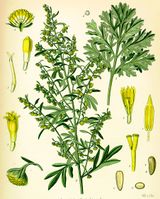Wormwood: Difference between revisions
Jump to navigation
Jump to search
Uncle Jesse (talk | contribs) Adding image |
Uncle Jesse (talk | contribs) No edit summary |
||
| (3 intermediate revisions by the same user not shown) | |||
| Line 1: | Line 1: | ||
[[file:Artemisia_absinthium.jpg|thumb| | [[file:Artemisia_absinthium.jpg|thumb|160px|right|Drawing of Artemisia absinthium]] | ||
The plant ''Artemisia Absinthium'', proverbial for its bitter taste. The leaves and tops are used in medicine as a tonic and vermifuge, and for making [[vermouth]] and [[absinthe]]; formerly also to protect clothes and bedding from moths and fleas, and in brewing | The plant ''Artemisia Absinthium'', proverbial for its bitter taste. The leaves and tops are used in medicine as a tonic and vermifuge, and for making [[vermouth]] and [[absinthe]]; formerly also to protect clothes and bedding from moths and fleas, and in brewing ale. It yields a dark green oil. Roman wormwood is ''A. pontica'' or ''A. Absinthium''; sea wormwood is ''A. maritima''. | ||
From Renfrow 1994: Wormwood contains [[thujone]], which can cause brain damage; it is addictive, with habitual use also causing vomiting, tremors, vertigo, hallucinations, violent behavior, and convulsions. Absinthe was deemed responsible for many deaths, and has been banned in several countries since the turn of the century. (McGee, p. 160. Merck, p. 2.) | From Renfrow 1994: Wormwood contains [[thujone]], which can cause brain damage; it is addictive, with habitual use also causing vomiting, tremors, vertigo, hallucinations, violent behavior, and convulsions. Absinthe was deemed responsible for many deaths, and has been banned in several countries since the turn of the century. (McGee, p. 160. Merck, p. 2.) | ||
[[Category: | [[Category:Ingredients]] | ||
Latest revision as of 23:50, 15 December 2022

The plant Artemisia Absinthium, proverbial for its bitter taste. The leaves and tops are used in medicine as a tonic and vermifuge, and for making vermouth and absinthe; formerly also to protect clothes and bedding from moths and fleas, and in brewing ale. It yields a dark green oil. Roman wormwood is A. pontica or A. Absinthium; sea wormwood is A. maritima.
From Renfrow 1994: Wormwood contains thujone, which can cause brain damage; it is addictive, with habitual use also causing vomiting, tremors, vertigo, hallucinations, violent behavior, and convulsions. Absinthe was deemed responsible for many deaths, and has been banned in several countries since the turn of the century. (McGee, p. 160. Merck, p. 2.)